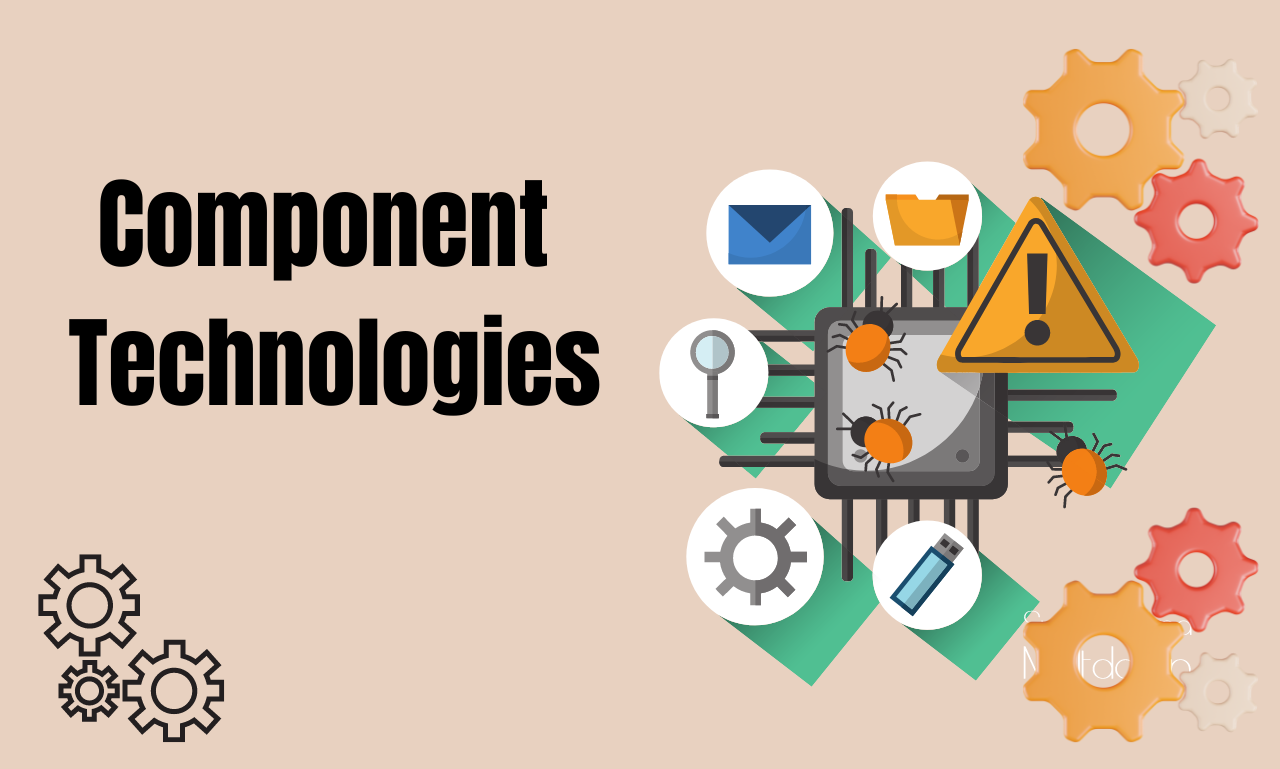What is component technologies in software engineering?
The term “component technologies” describes the area of software engineering concerned with creating reusable, modular, and independent software components. These components are modular, reusable chunks of functionality that can be assembled into any sophisticated system or program you can imagine.
Component technology’s core ideas include the following:
Component-based Development: This method stresses the development of software systems by assembling existing components. In order to facilitate their capability and replacement, components are often built with well-specified interfaces.
- Component Models: Component models provide the norms and guidelines that make it possible to create, distribute, and run components. Common Object Request Broker Architecture (CORBA), JavaBeans, and the Component Object Model (COM) are all well-known examples of component models.
- Interoperability: Component technologies help with interoperability by allowing components to talk to one another and collaborate regardless of the platform or language being used; this paves the way for developers to use pre-existing components and easily incorporate them into new apps.
- Life Cycle Management & Development: Component technologies provide means for delivering and managing components throughout their lifespan; this entails thinking about things like versions, dependencies, configuration, monitoring, and security.
- Component Repositories: Repositories are often used to store and distribute components to encourage reuse and sharing. The components that satisfy the needs of a developer may be found and downloaded from these repositories.
- By using pre-existing components with well-defined interfaces, component technologies enable developers to construct complicated systems with relative ease.
- Components of Component Technologies
- The creation, deployment, and exploitation of software components are made possible by component technologies, which are made up of a number of critical components. The key components are listed below:
- Component Model: This model specifies the requirements, guidelines, and regulations for developing and using components. It defines the standards for component deployment, lifecycle management, and interaction. The Component Object Model (COM), Common Object Request Broker Architecture (CORBA), and JavaBeans are all examples of component models.
- Component Container/Runtime Environment: The platform or infrastructure where components are executed and controlled is the Component Container or Runtime Environment. It enables the execution of components by providing runtime services like communication, security, threading, and memory management. There is the Java Virtual Machine (JVM) for Java-based components, and for .NET components, there is the .NET Common Language Runtime (CLR).
- Component Interface: This interface outlines the agreement terms between the component and its users. The interface defines how the component may communicate with other parts of a system or other components. The interface specifies how it may exchange data with other components or systems.
- Component Implementation: The actual code or logic that implements a component’s functionality is called the “component implementation.” The methods, attributes, and events specified in the component interface must be implemented. Depending on the underlying technology, Java, C#, or C++ may be used to write the implementation code.
- Component Implementation: It entails putting together a deployable package containing the component and any prerequisites and dependencies. This module may be a JAR, DLL, or other file type recognized by the underlying technology. Configuring the component and putting it into the container or runtime environment is also part of the deployment.
- Component Lifecycle Management: Component Lifecycle Management manages components from the time they are instantiated through their use and eventual decommissioning. Component instantiation, configuration, versioning, dependency management, monitoring, and lifecycle events handling are all a part of this process.
- Component Repository: A repository for software components is a central database for storing and managing software building blocks. It serves as a repository for reusable components that programmers can browse, find, download, and integrate into their projects. Version control, metadata management, and quality assurance are all common characteristics of component repositories.
- Component Interoperability Protocols: In order to facilitate communication and interaction between components, component technologies often depend on interoperability protocols. These protocols govern the components’ ability to share information, call one another’s methods, and deal with RPCs. The Simple Object Access Protocol (SOAP), the Representational State Transfer (REST), and messaging protocols like the Java Message Service (JMS) are all good examples.
The creation, deployment, integration, and use of software components inside component-based systems are made more accessible by the collaboration of these components.
Types of Component Technologies
The software industry makes use of several component technologies. Here are a few that usually come up:
- Object-Oriented Components: Examples of object-oriented component technologies include technologies like JavaBeans and the.NET Framework, which use object-oriented programming concepts to construct reusable software components. The components are simple to include in object-oriented systems since they contain data and behavior.
- Web Components: These components are a collection of web platform standards that enable the development of reusable user interface (UI) components for websites. They include the HTML import method, HTML templates, custom elements, and shadow DOM. Web components allow for the creation of UI elements that are portable and useable in a variety of contexts because of their modularity, encapsulation, and reusability.
- Service-Oriented Architecture (SOA): It is a method of architecture that treats services like components. In SOA, services are modules of functionality that operate autonomously and are accessible across a network. These services have well-defined interfaces and use industry-standard protocols like Simple Object Access Protocol (SOAP) and Representational State Transfer (REST) for communication.
- Component-Based Development Frameworks: Frameworks for creating and managing software components are easier to create and deploy with the help of component-based development frameworks. The Microsoft.NET Framework, the Spring Framework, and the Java Platform, Enterprise Edition (EE) are just a few examples.
- Middleware Technologies: Enterprise Service Bus (ESB) and Common Object Request Broker Architecture (CORBA) are two examples of middleware technologies that may be used to construct distributed component-based systems. They make it possible for components written in various languages and operating systems to exchange data and interact with one another.
- Component-Based Modeling: Techniques and notations for modeling and designing software systems as collections of components are made available by component-based modeling methods like Component-Based Development (CBD) and Unified Modeling Language (UML). These models accurately represent the system components, including their structure, behavior, and relationships.
- Component Repositories and Package Managers: Tools and systems called “component repositories” and “package managers” make finding, sharing, and distributing software components easier. They serve as a hub where developers can share, discover, and access the necessary components for their projects. NuGet and npm (Node Package Manager) are just a few examples.
The project’s needs and objectives influence component technology selection, the chosen architectural design, and the programming language.
Benefits of Component Technologies
There are several advantages to using component technologies while creating software. Some of the main benefits are as follows:
- Reusability: Components are built to be independent and adaptable so that programmers may use the same code in different projects; this saves time and effort in development by eliminating the need to create existing functionality.
- Modularity: Components encourage a modular design in which the various system pieces are packaged as self-contained modules. Because of this, the code is easier to maintain, update, and scale without impacting other parts of the system.
- Productivity: Component technologies increase productivity by allowing programmers to concentrate on putting together and integrating parts rather than creating everything from the start; this shortens the time it takes to create a product since components provide tried-and-true functionality that can be quickly included in applications.
- Collaboration: Components also promote teamwork by making it easier for different groups to work together. By breaking down a more significant system into more manageable pieces with well-defined interfaces, several groups of developers may work on separate parts of the system concurrently.
- Interoperability: Component technologies foster cross-platform, cross-language, and cross-system interoperability; this improves the adaptability and scalability of software systems by allowing components to be easily integrated, reused, and shared within various settings.
- Maintainability: Components separate and encapsulate specific capabilities, making locating and repairing problems simpler. Modularizing the system makes upkeep easier, lessens the effect of modifications, and improves the software’s general reliability.
- Scalability: Components may be scaled up or down separately to meet fluctuating demand. Deploying multiple instances of a component increases performance and resource consumption by allowing the system to manage greater demands without disrupting the overall program.
These benefits allow for more streamlined and effective software development procedures, ultimately leading to more reliable and adaptable final products.
How Component Technologies Help B2B Suppliers and Manufacturers
Component technologies have a significant impact on both B2B suppliers and manufacturers in several different ways. Some key aspects include:
- Product Customization: Component technologies make it easier for B2B suppliers and manufacturers to create and personalize goods. They may concentrate on assembling and integrating the pre-built components to provide customized solutions for their clients.
- Standardization and Reusability: Component Technologies encourage product and project reusability and standardization. Suppliers and manufacturers may pool resources by building a repository of reusable parts that can be applied to various products; this improves uniformity, eliminates unnecessary work, and speeds up the development cycle.
- Flexibility and Scalability: Solutions may be made scalable and adaptable with the help of components. B2B suppliers and manufacturers might create modular systems to accommodate future growth and change. Because of their scalability, they can respond quickly to shifting needs from customers, the marketplace, and technology developments.
- Integration and Interoperability: Component technologies improve the capacity to communicate and integrate with other systems and platforms. Components developed by B2B suppliers and manufacturers may be easily integrated into their clients’ current infrastructures thanks to well-defined interfaces and compatibility standards. Because of this, they are more likely to work together, and their interoperable solutions will increase the value of their goods.
- Supply Chain Management: Component technologies facilitate efficient supply chain management. Manufacturers may easily include components from suppliers if those components are built to the manufacturer’s specifications; this enhances supply chain efficiency by standardizing and shortening the time it takes to make purchases.
- Upgrades and Maintenance: Suppliers and manufacturers benefit from the reduced complexity of maintenance and upgrades made possible by modular design. Updating or repairing a single component without reloading the complete system is possible. As a result, there is less need for repairs, less interference with daily operations, and the goods are easier to maintain.
- Cost Efficiency: Component technologies help keep costs down by cutting down on time spent on development and using economies of scale. By creating and selling components to various manufacturers, suppliers may more evenly distribute their development expenses. In turn, manufacturers may save costs by not starting from scratch and instead using pre-built components.
- Competitive Advantage: Advantage in the MarketB2B suppliers and manufacturers alike may get an advantage by using component technology innovatively. They may set themselves apart from the competition by providing flexible and adaptable solutions to their customers’ individual demands. As a result, they can get new items to market more quickly, respond to shifts in the market more effectively, and provide their customers with better service.
In conclusion, the use of component technologies helps B2B suppliers and manufacturers by providing the groundwork for creating adaptable, modular, and value-added solutions to satisfy the changing needs of B2B clients.

